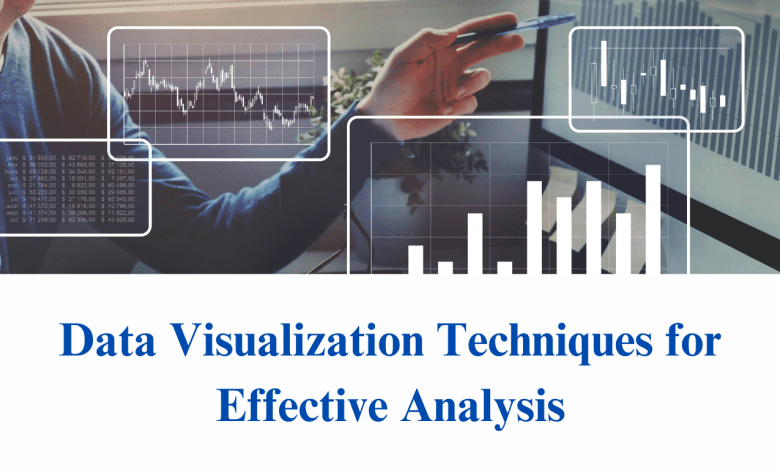Data Visualization Techniques for Effective Analysis
The Power of Visualizing Data

Introduction
In today’s data-driven world, the ability to extract meaningful insights from vast amounts of information is a valuable skill. Data analytics has become an indispensable tool in various fields, from business and finance to healthcare and education. As the demand for data professionals continues to grow, it’s essential to equip oneself with the right skills and knowledge. In this article, we will explore the significance of data visualization techniques in effective data analysis and introduce you to the best data analytics course in chandigarh.
In the digital age, data is an invaluable asset, and mastering data analytics is a gateway to unlocking its potential. Data visualization is the bridge that transforms raw data into actionable insights. It empowers individuals to make informed decisions, uncover hidden trends, and communicate findings effectively. When seeking the best data analytics course, ensure it offers a comprehensive curriculum, practical experience, and faculty expertise. Your choice of course can shape your future in the data-driven world, providing opportunities for impactful career growth. Embrace the power of data visualization as you embark on your journey towards becoming a proficient data analyst.
The Power of Data Visualization
Data visualization is the practice of representing data graphically, enabling individuals to grasp complex information quickly and make informed decisions. It’s an integral part of data analysis, as it helps uncover patterns, trends, and outliers that might be hidden in raw data. Here are some key reasons why data visualization is crucial in the world of data analytics:
Enhanced Understanding: Humans are inherently visual creatures, and we process visual information much faster than text or numbers. Data visualization transforms abstract data into visual representations such as charts, graphs, and dashboards, making it easier for analysts and decision-makers to understand the data’s significance.
Identifying Patterns: Visualizations help identify patterns and correlations within data that might go unnoticed in raw datasets. For example, a line chart can reveal trends over time, while a scatter plot can show relationships between variables.
Effective Communication: Data visualization simplifies complex findings, making it easier to communicate insights to non-technical stakeholders. This is particularly important in fields like business, where data-driven decisions need to be shared across departments.
Quick Insights: With the right visualization tools, you can quickly generate visual representations of data, allowing for rapid exploration and analysis. This agility is essential when dealing with large datasets or time-sensitive decisions.
Visualization can help detect errors and outliers in data, enabling data analysts to clean and preprocess data effectively.
Now that we understand the importance of data visualization in data analysis, let’s delve into some essential techniques that can make your data analysis endeavors more effective.
Essential Data Visualization Techniques
Bar Charts and Pie Charts: These are classic visualization techniques for representing categorical data. Bar charts are excellent for comparing quantities between different categories, while pie charts are useful for showing the composition of a whole.
Line Charts: Line charts are ideal for displaying trends over time. They are commonly used in finance to visualize stock prices or in climate science to show temperature variations.
Scatter Plots: Scatter plots are excellent for visualizing relationships between two continuous variables. They help identify correlations, outliers, and clusters within data.
Histograms: Histograms are useful for visualizing the distribution of a single variable. They divide the data into bins and display the frequency of data points in each bin, helping you understand the data’s central tendency and spread.
Heatmaps: Heatmaps are particularly valuable when dealing with matrices or two-dimensional data. They use color intensity to represent values, making it easy to spot patterns and anomalies.
Box Plots: Box plots, also known as box-and-whisker plots, provide a concise summary of the distribution of a dataset, including median, quartiles, and potential outliers.
Geospatial Visualization: When dealing with location-based data, maps and geospatial visualizations are essential. They can reveal geographic patterns and trends, making them crucial in fields like urban planning and epidemiology.
Interactive Dashboards: Interactive dashboards, often created using tools like Tableau or Power BI, allow users to explore data dynamically. They are invaluable for business intelligence and data-driven decision-making.
Choosing the Best Data Analytics Course
If you’re interested in acquiring or honing your data analytics skills, it’s crucial to choose the right course. While there are many options available, it’s important to consider factors like course content, faculty expertise, and practical applications. a city known for its educational institutions, the Best Data Analytics Course is one that aligns with your career goals and offers comprehensive training in this field.
Also Read-10 Essential Features to have in an On-Demand Service App
Here are some key factors to consider when selecting a data analytics course:
Curriculum: Review the course syllabus to ensure it covers a wide range of data analytics techniques, including data visualization. Look for courses that teach both theory and practical applications.
Faculty: The quality of instruction is paramount. Check the credentials and experience of the faculty members. Are they experts in the field of data analytics?
Hands-On Experience: Practical experience is essential in data analytics. Find out if the course includes hands-on projects and real-world case studies.
Industry Connections: A good course should have connections with local industries, allowing students to gain real-world experience through internships or collaborations.
Certification: Consider whether the course offers any certifications that are recognized in the industry. Certifications can boost your credibility as a data analyst.
Flexibility: Evaluate the course’s flexibility in terms of timing and mode of delivery. Does it offer part-time or online options to accommodate your schedule?
Student Feedback: Look for reviews or feedback from past students to get an idea of their experiences and outcomes after completing the course.
Career Support: Check if the course provides career support services such as job placement assistance or networking opportunities.
Conclusion
Data visualization techniques play a crucial role in effective data analysis. They enable individuals to extract insights, identify patterns, and communicate findings efficiently. Whether you’re a data analyst, a business professional, or someone looking to enter the field of data analytics, understanding and mastering data visualization is essential.
When choosing a data analytics course in Chandigarh, consider the factors mentioned above to make an informed decision. The right course can equip you with the skills and knowledge needed to excel in the world of data analysis and visualization. As the demand for data professionals continues to grow, investing in your data analytics education can open doors to exciting career opportunities.
So, if you’re looking to embark on a journey into the world of data analytics, choose wisely, and let the power of data visualization guide you towards meaningful insights and impactful decision-making.
A city known for its educational institutions, the Best Data Analytics Course is one that aligns with your career goals and offers comprehensive training in this field. When choosing a data analytics course in Chandigarh, consider factors like curriculum, faculty expertise, practical experience, industry connections, certifications, flexibility, student feedback, and career support. The right course can equip you with the skills and knowledge needed to excel in the world of data analysis and visualization. So, if you’re looking to embark on a journey into the world of data analytics , choose wisely, and let the power of data visualization guide you towards meaningful insights and impactful decision-making.






